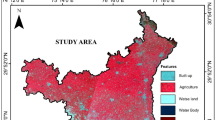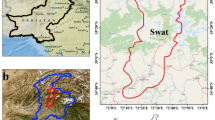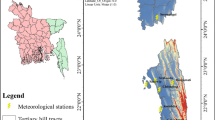Abstract
Soil erosion trend depends on effective land use and land cover dynamics since overwhelming population growth in tropical region. The objective of this paper is to assess potential mean annual soil erosion rate, and conversion of erosion class incorporate with land use and land cover change in plateau fringe, undulating and low land of Kangsabati basin using Revised Universal Soil Loss Equation (RUSLE) and multiple logistic regression (MLR). Both models denote potential mean soil erosion zone as 55% corresponds at low level in low land than medium level as 30% in undulating topography and high level as 15% in plateau fringe site. RUSLE indicates erosion rate increases with expanding area in degraded forest (169 ton ha−1 year−1, 137 km2), dense forest (134 ton ha−1 year−1, 55 km2) and settlement area (30 ton ha−1 year−1, 105 km2), whereas erosion rate decreases with reducing the area in barren land with laterite outcrop (− 154 ton ha−1 year−1, − 93 km2), double crop (− 40 ton ha−1 year−1, − 201 km2) and single crop yield (− 1 ton ha−1 year−1, − 62 km2) from 2002 to 2016. MLR predicts barren land with laterite outcrop and dense forest play a crucial role to determine the erosion susceptibility in plateau fringe, while degraded forest and single crop signify erosion susceptibility in undulating topography. Settlement and double crop are more significant in low land with proper validation. Model comparison depicts same class conversion finds out as 63.73% (low-to-low class, 41%) in low land, whereas high-to-low class finds in undulating topography (23%) and low-to-high class in plateau fringe (13%).



















Similar content being viewed by others
References
Akgün, A., & Türk, N. (2011). Mapping erosion susceptibility by a multivariate statistical method: A case study from the Ayvalık region, NW Turkey. Computers & Geosciences, 37(9), 1515–1524.
Angima, S. D., Stott, D. E., O’neill, M. K., Ong, C. K., & Weesies, G. A. (2003). Soil erosion prediction using RUSLE for central Kenyan highland conditions. Agriculture, Ecosystems & Environment, 97(1–3), 295–308.
Bakker, M. M., Govers, G., van Doorn, A., Quetier, F., Chouvardas, D., & Rounsevell, M. (2008). The response of soil erosion and sediment export to land-use change in four areas of Europe: The importance of landscape pattern. Geomorphology, 98(3–4), 213–226.
Beguería, S. (2006). Identifying erosion areas at basin scale using remote sensing data and GIS: A case study in a geologically complex mountain basin in the Spanish Pyrenees. International Journal of Remote Sensing, 27(20), 4585–4598.
Bhattacharya, R. K., Das Chatterjee, N., & Das, K. (2020). Estimation of erosion susceptibility and sediment yield in ephemeral channel using RUSLE and SDR model: Tropical plateau fringe region, India. In P. Shit, H. Pourghasemi, G. Bhunia (Eds.), Gully erosion studies from India and surrounding regions. Advances in Science, Technology & Innovation (pp. 163–185). Cham: Springer. https://doi.org/10.1007/978-3-030-23243-6_10.
Biswas, S. (2012). Estimation of soil erosion using remote sensing and GIS and prioritization of catchments. International Journal of Emerging Technology and Advanced Engineering, 2(7), 124–128.
Bready, N. C., & Well, R. R. (2005). The nature and properties of soil. Singapore: Pearson Prentice Hall.
Cox, C., & Madramootoo, C. (1998). Application of geographic information systems in watershed management planning in St. Lucia. Computers and Electronics in Agriculture, 20(3), 229–250.
Dai, F. C., & Lee, C. F. (2002). Landslide characteristics and slope instability modeling using GIS, Lantau Island, Hong Kong. Geomorphology, 42(3–4), 213–228.
Desmet, P. J. J., & Govers, G. (1996). A GIS procedure for automatically calculating the USLE LS factor on topographically complex landscape units. Journal of Soil and Water Conservation, 51(5), 427–433.
Dissanayake, D., Morimoto, T., & Ranagalage, M. (2018). Accessing the soil erosion rate based on RUSLE model for sustainable land use management: A case study of the Kotmale watershed, Sri Lanka. Modeling Earth Systems and Environment, 5(1), 291–306.
Djoukbala, O., Hasbaia, M., Benselama, O., & Mazour, M. (2019). Comparison of the erosion prediction models from USLE, MUSLE and RUSLE in a Mediterranean watershed, case of Wadi Gazouana (NW of Algeria). Modeling Earth Systems and Environment, 5(2), 725–743.
Fernandez, C., Wu, J. Q., McCool, D. K., & Stöckle, C. O. (2003). Estimating water erosion and sediment yield with GIS, RUSLE, and SEDD. Journal of Soil and Water Conservation, 58(3), 128–136.
Ganasri, B. P., & Ramesh, H. (2016). Assessment of soil erosion by RUSLE model using remote sensing and GIS—A case study of Nethravathi Basin. Geoscience Frontiers, 7(6), 953–961.
Hembram, T., Paul, G. C., & Saha, S. (2019). Spatial prediction of susceptibility to gully erosion in Jainti River basin, Eastern India: A comparison of information value and logistic regression models. Modeling Earth Systems and Environment, 5(2), 689–708.
Hirzel, A. H., Le Lay, G., Helfer, V., Randin, C., & Guisan, A. (2006). Evaluating the ability of habitat suitability models to predict species presences. Ecological Modelling, 199(2), 142–152.
Hoyos, N., Waylen, P. R., & Jaramillo, Á. (2005). Seasonal and spatial patterns of erosivity in a tropical watershed of the Colombian Andes. Journal of Hydrology, 314(1–4), 177–191.
Imam, E., & Kushwaha, S. P. S. (2013). Habitat suitability modelling for Gaur (Bos gaurus) using multiple logistic regression, remote sensing and GIS. Journal of Applied Animal Research, 41(2), 189–199.
Indian Council of Agricultural Research & National Academy of Agricultural Science (ICAR & NAAS). (2010). Report on degraded and wastelands of India status and spatial distribution.
Jiang, Z., Lian, Y., & Qin, X. (2014). Rocky desertification in Southwest China: Impacts, causes, and restoration. Earth-Science Reviews, 132, 1–12.
Jordan, G., Van Rompaey, A., Szilassi, P., Csillag, G., Mannaerts, C., & Woldai, T. (2005). Historical land use changes and their impact on sediment fluxes in the Balaton basin (Hungary). Agriculture, Ecosystems & Environment, 108(2), 119–133.
Kachouri, S., Achour, H., Abida, H., & Bouaziz, S. (2015). Soil erosion hazard mapping using Analytic Hierarchy Process and logistic regression: A case study of Haffouz watershed, central Tunisia. Arabian Journal of Geosciences, 8(6), 4257–4268.
Kalambukattu, J. G., & Kumar, S. (2017). Modelling soil erosion risk in a mountainous watershed of Mid-Himalaya by integrating RUSLE model with GIS. Eurasian Journal of Soil Science, 6(2), 92.
Kavian, A., Hoseinpoor Sabet, S., Solaimani, K., & Jafari, B. (2017). Simulating the effects of land use changes on soil erosion using RUSLE model. Geocarto International, 32(1), 97–111.
Kijowska-Strugała, M., Bucała-Hrabia, A., & Demczuk, P. (2018). Long-term impact of land use changes on soil erosion in an agricultural catchment (in the Western Polish Carpathians). Land Degradation and Development, 29(6), 1871–1884.
Lai, C., Wang, Z., Chen, X., Xu, C. Y., Yang, B., Meng, Q., et al. (2016). A procedure for assessing the impacts of land-cover change on soil erosion at basin scale. Hydrology Research, 47(5), 903–918.
Li, R., Bennett, J., & Wang, X. (2013). Predicting environmental impacts for assessing land use change options in Sichuan Province, China. Land Use Policy, 30(1), 784–790.
López-Vicente, M., Lana-Renault, N., García-Ruiz, J. M., & Navas, A. (2011). Assessing the potential effect of different land cover management practices on sediment yield from an abandoned farmland catchment in the Spanish Pyrenees. Journal of Soils and Sediments, 11(8), 1440–1455.
Mahala, A. (2018). Soil erosion estimation using RUSLE and GIS techniques—A study of a plateau fringe region of tropical environment. Arabian Journal of Geosciences, 11(13), 335.
McCool, D. K., Brown, L. C., Foster, G. R., Mutchler, C. K., & Meyer, L. D. (1987). Revised slope steepness factor for the Universal Soil Loss Equation. Transactions of the ASAE, 30(5), 1387–1396.
Millward, A. A., & Mersey, J. E. (1999). Adapting the RUSLE to model soil erosion potential in a mountainous tropical watershed. Catena, 38(2), 109–129.
Mukhopadhyay, S. (1992). Terrain analysis of river basin. Delhi: Vora publication.
Nasir, N., & Selvakumar, R. (2018). Influence of land use changes on spatial erosion pattern, a time series analysis using RUSLE and GIS: the cases of Ambuliyar sub-basin, India. Acta Geophysica, 66(5), 1121–1130.
National forest report, India http://fsi.nic.in/foresreport(2005) (2017).
Pal, S., & Talukdar, S. (2018). Application of frequency ratio and logistic regression models for assessing physical wetland vulnerability in Punarbhaba river basin of Indo-Bangladesh. Human and Ecological Risk Assessment: An International Journal, 24(5), 1291–1311.
Perović, V., Jakšić, D., Jaramaz, D., Koković, N., Čakmak, D., Mitrović, M., et al. (2018). Spatio-temporal analysis of land use/land cover change and its effects on soil erosion (Case study in the Oplenac wine-producing area, Serbia). Environmental Monitoring and Assessment, 190(11), 675.
Poesen, J., Nachtergaele, J., Verstraeten, G., & Valentin, C. (2003). Gully erosion and environmental change: Importance and research needs. CATENA, 50(2–4), 91–133.
Pradhan, A. M. S., & Kim, Y. T. (2018). GIS-based landslide susceptibility model considering effective contributing area for drainage time. Geocarto International, 33(8), 810–829.
Prasannakumar, V., Shiny, R., Geetha, N., & Vijith, H. (2011). Spatial prediction of soil erosion risk by remote sensing, GIS and RUSLE approach: a case study of Siruvani river watershed in Attapady valley, Kerala, India. Environmental Earth Sciences, 64(4), 965–972.
Renard, K. G., & Freimund, J. R. (1994). Using monthly precipitation data to estimate the R factor in the revised USLE. Journal of Hydrology, 157(1), 287–306.
Renard, K. G., Foster, G. R., Weesies, G. A., McCool, D. K., & Yoder, D. C. (1997). Predicting soil erosion by water: a guide to conservation planning with the Revised Universal Soil Loss Equation (RUSLE) (Vol. 703). Washington, DC: United States Department of Agriculture.
Sahaar, A. S. (2013). Erosion mapping and sediment yield of the Kabul River Basin. Fort Collins, CO: Afghanistan.
Sarkar, T., & Mishra, M. (2018). Soil erosion susceptibility mapping with the application of logistic regression and artificial neural network. Journal of Geovisualization and Spatial Analysis, 2(1), 8.
Santos, J. C. N. D., Andrade, E. M. D., Medeiros, P. H. A., Guerreiro, M. J. S., & Palácio, H. A. D. Q. (2017). Land use impact on soil erosion at different scales in the Brazilian semi-arid. Revista Ciência Agronômica, 48(2), 251–260.
Shit, P. K., Nandi, A. S., & Bhunia, G. S. (2015). Soil erosion risk mapping using RUSLE model on Jhargram sub-division at West Bengal in India. Modeling Earth Systems and Environment, 1(3), 28.
Syvitski, J. P., Vörösmarty, C. J., Kettner, A. J., & Green, P. (2005). Impact of humans on the flux of terrestrial sediment to the global coastal ocean. Science, 308(5720), 376–380.
Toubal, A. K., Achite, M., Ouillon, S., & Dehni, A. (2018). Soil erodibility mapping using the RUSLE model to prioritize erosion control in the Wadi Sahouat basin, North-West of Algeria. Environmental Monitoring and Assessment, 190(4), 210.
UN-FAO. (2001). Strategic environmental assessment: An assessment of the impact of cassava production and processing on the environment and biodiversity (Vol. 5). Rome.
Vijith, H., Hurmain, A., & Dodge-Wan, D. (2018). Impacts of land use changes and land cover alteration on soil erosion rates and vulnerability of tropical mountain ranges in Borneo. Remote Sensing Applications: Society and Environment, 12, 57–69.
Wang, J., Rich, P. M., Price, K. P., & Kettle, W. D. (2004). Relations between NDVI and tree productivity in the central Great Plains. International Journal of Remote Sensing, 25(16), 3127–3138.
Williams, J., Nearing, M., Nicks, A., Skidmore, E., Valentin, C., King, K., et al. (1996). Using soil erosion models for global change studies. Journal of Soil and Water Conservation, 51(5), 381–385.
Wischmeier, W. H. (1960). Cropping-management factor evaluations for a universal soil-loss equation 1. Soil Science Society of America Journal, 24(4), 322–326.
Wischmeier, W. H., & Smith, D. D. (1978). Predicting rainfall erosion losses—A guide to conservation planning. Washington, DC: U.S. Department of Agriculture-Agriculture Handbook 537. U.S. Government Printing Office.
Xiao, L., Yang, X., Chen, S., & Cai, H. (2015). An assessment of erosivity distribution and its influence on the effectiveness of land use conversion for reducing soil erosion in Jiangxi, China. CATENA, 125, 50–60.
Acknowledgements
Authors are thankful to Survey of India (SOI), Irrigation Office of Paschim Medinipur and Bankura, District Land & Land Reforms officer of the Paschim Midnapore and Bankura districts, WB in India. Authors are also grateful to the anonymous reviewers for their valuable comments and suggestions to improve the quality of this article.
Author information
Authors and Affiliations
Corresponding author
Additional information
Publisher's Note
Springer Nature remains neutral with regard to jurisdictional claims in published maps and institutional affiliations.
Rights and permissions
About this article
Cite this article
Bhattacharya, R.K., Das Chatterjee, N. & Das, K. Land use and Land Cover change and its resultant erosion susceptible level: an appraisal using RUSLE and Logistic Regression in a tropical plateau basin of West Bengal, India. Environ Dev Sustain 23, 1411–1446 (2021). https://doi.org/10.1007/s10668-020-00628-x
Received:
Accepted:
Published:
Issue Date:
DOI: https://doi.org/10.1007/s10668-020-00628-x




